
Yangon is Myanmar's largest city, and its economic and cultural centre of Myanmar. The city was occupied by the British in 1852 when it became the centre of the Burmese Raj. The resulting influx of traders, diplomats and wealth transformed the city into a thriving regional hub. The legacy of this time is evident in the decaying though stately colonial buildings found along the Rangoon River and toward the centre of town. The city has myriad tourist attractions, most notably the famous Shwedagon Pagoda, which justifies a visit to the city all by itself and is the country's most beloved landmark. There are also markets to explore, and Yangon is a glorious city to trawl for jewels.
Yangon is hot and humid, especially at midday when most of the population takes refuge indoors or in the shade of a temple or banyan tree. It is a noisy and chaotic place too, with congested traffic, orange robed monks, neon signs and golden temple spires clashing in a visual landscape of uniquely Asian contradictions. Yangon is also considered one of Asia's safest big cities as far as travellers are concerned, meaning that the bustling chaos can be explored with little fear of crime.

Travel Guide powered by Word Travels, copyright © 2023 Globe Media Ltd. By its very nature information in this travel guide is subject to change at short notice and travellers are urged to verify information on which they're relying with the relevant authorities. Neither Globe Media Ltd nor Travel Vogue can accept any responsibility for any loss or inconvenience to any person as a result of information contained above.